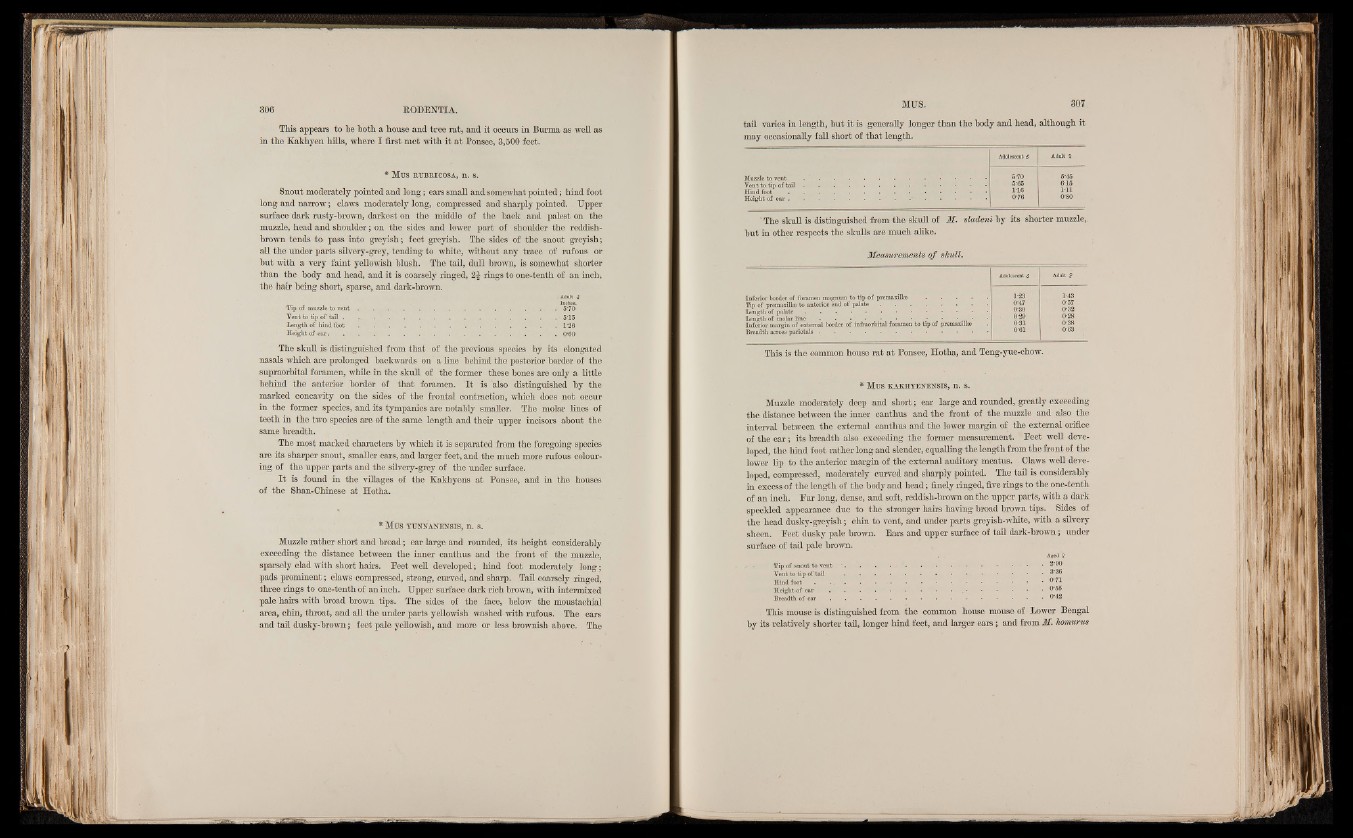
This appears to be both a bouse and tree rat, and it occurs in Burma as well as
in the Kakhyen bills, where I first met with it at Ponsee, 3,500 feet.
* Mus b u b b i c o s a , n. s .
Snout moderately pointed and long; ears small and somewhat pointed; hind foot
long and narrow; claws moderately long, compressed and sharply pointed. Upper
surface dark rusty-brown, darkest on the middle of the hack and palest on the
muzzle, head and shoulder; on the sides and lower part of shoulder the reddish-
brown tends to pass into greyish; feet greyish. The sides of the snout greyish;
all the under parts silvery-grey, tending to white, without any trace of rufous or
but with a very faint yellowish blush. The tail, dull brown, is somewhat shorter
than the body and head, and it is coarsely ringed, 2^ rings to one-tenth of an inch,
the hair being short, sparse, and dark-brown.
. Adult S
Inches.
Tip of muzzle to vent .. 5‘70
Vent to tip o f tail ..................................................................................................................... • 5‘15
Length of hind f o o t ....................................................................................................................................1*26
Height of ear....................................................................................................................................................... 0 -60
The skull is distinguished from that of the previous species by its elongated
nasals which are prolonged backwards on a line behind the posterior border of the
supraorbital foramen, while in the skull of the former these bones are only a little
behind the anterior border of that foramen. I t is also distinguished by the
marked concavity on the sides of the frontal contraction, which does not occur
in the former species, and its tympanies are notably smaller. The molar lines of
teeth in the two species are of the same length and their upper incisors about the
same breadth.
The most marked characters by which it is separated from the foregoing species
are its sharper snout, smaller ears, and larger feet, and the much more rufous colouring
of the upper parts and the silvery-grey of the under surface.
I t is found in the villages of the Kakhyens at Ponsee, and in the houses
of the Shan-Chinese at Hotha.
* M U S YUNNANENSIS, n . S . ’
Muzzle rather short and broad; ear large and rounded, its height considerably
exceeding the distance between the inner canthus and the front of the muzzle,
sparsely clad with short hairs. Peet well developed; hind foot moderately long;
pads prominent; claws compressed, strong, curved, and sharp. Tail coarsely ringed,
three rings to one-tenth of an inch. Upper surface dark rich brown, with intermixed
pale hairs with broad brown tips. The sides of the face, below the moustachial
area, chin, throat, and all the under parts yellowish washed with rufous. The ears
and tail dusky-brown; feet pale yellowish, and more or less brownish above. The
tail varies in length, but it is generally longer than the body and head, although it
may occasionally fall short of that length.
Adolescent S Adult $
Muzzle to vent . 570 6-45
Vent to tip of t a i l ........................................................................................ ......... 6‘15
Height of ear ........................................................... ' • •• ; 0-76
' The skull is distinguished from the skull of M. sladeni by its shorter muzzle,,
but in other respects the skulls are much alike.
Meamrements o f skull.
Inferior border of foramen magnum to tip o f premaxilbe . . . .
Tip o f premaxillse to anterior end o f p a l a t e ............................................................
Length o f palate . . . . . . . . . . . .
Length of molar line • • • ' • • • * . ■ * •
Inferior margin of external border of infraorbital foramen to tip of premaxillse
Breadth across parietals . . . . . . . . . . .
This is the common house rat at Ponsee, Hotha, and Teng-yue-chow.
* Mus KAKHYENENSIS, n . S.
Muzzle moderately deep and short; ear large and rounded, greatly exceeding
the distance between the inner canthus and the front of the muzzle and also the
interval between the external canthus and the lower margin of the external orifice
of the ear; its breadth also exceeding the former measurement. Peet well developed,
the hind foot rather long and slender, equalling the length from the front of the
lower lip to the anterior margin of the external auditory meatus. Claws well developed,
compressed, moderately curved and sharply pointed. The tail is considerably
in excess of the length of the body and head; finely ringed, five rings to the one-tenth
of an inch. Pur long, dense, and soft, reddish-brown on the upper parts, with a dark
speckled appearance due to the stronger hairs having broad brown tips. Sides of
the head dusky-greyish; chin to vent, and under parts greyish-white, with a silvery
sheen. Peet dusky pale brown. Ears and upper surface of tail dark-brown; under
surface of tail pale brown.
Tip of snout to vent
Vent to tip of tail
Hind foot . •
Height o f ear .
Breadth of ear
Aged 9
2-90
This mouse is distinguished from the common house mouse of Lower Bengal
by its relatively shorter tail, longer hind feet, and larger ears; and from M. homwrus